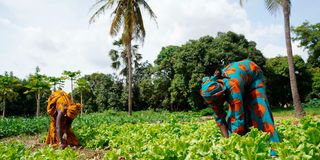Food insecurity can compromise HIV management: study

Farmers harvesting lettuce in the village. PHOTO|Shutterstock
What you need to know:
- Agricultural and livelihood interventions improve the well-being of people living with HIV/Aids in the country, a study has shown.
- Food insecurity refers to limited availability of nutritionally adequate foods or the inability to acquire personally acceptable foods in socially acceptable ways.
- Dr Jeni Miller: If we ensure that people have access to healthy plant-based diets and improve their nutrition, it will have tremendous health benefits
Agricultural and livelihood interventions improve the well-being of people living with HIV/Aids in the country, a study has shown.
The findings of the study on the effects of a multi-sectoral agricultural intervention on HIV health outcomes among adults in Kenya was published last week in the Journal of the American Medical Association (JAMA).
The clinical trial focused on how food insecurity and HIV health outcomes are linked through nutrition, mental health and behaviour.
“Agricultural interventions that improve productivity and livelihoods hold promise as a way of addressing food insecurity and the underpinnings of poor health among people living with HIV in resource-limited settings,” states the study.
Food insecurity refers to limited availability of nutritionally adequate foods or the inability to acquire personally acceptable foods in socially acceptable ways.
The study found that food insecurity can worsen immunologic and virologic responses and cause treatment interruptions and non-adherence when it comes to HIV.
Among people living with HIV, food insecurity is associated with declines in physical health, decreased viral suppression, worse immunologic status, and increased incidence of serious illness and mortality.
The linkages between HIV/AIDS and food insecurity, in which each heightens vulnerability to and increases the severity of the other, are often amplified by weak healthcare systems, unsustainable agricultural practices and entrenched poverty.
The study participants were selected from 16 health facilities in Kisumu, Homa Bay, and Migori counties that provide HIV care and treatment. Participants were 18 years or older, living with HIV, and receiving anti-retroviral therapy (ART) for longer than six months, and had moderate to severe food insecurity and access to arable land and water. They were then followed up every six months for 24 months. A total of 720 participants were enrolled, with 366 in the intervention group and 354 in the control group.
At the end of the study, HIV viral suppression improved in both groups with a decrease in food insecurity. At the same time, the number of those with depression during the study period declined with self-confidence improving.
The researchers developed an intervention known as Shamba Maisha to address the root causes of food insecurity and poor health among the participants.
Home visits were done on interested and potentially eligible individuals to verify that each participant had access to agricultural land and to surface water or a shallow, hand-dug well.
The participants were then given a loan of $175 (about Sh21,000) to purchase a human-powered irrigation pump, fertiliser, seeds and pesticides combined with the provision of training in sustainable agriculture and financial literacy.
To ensure that food insecurity does not compromise the efforts towards universal access to effective HIV care, health agencies have recommended integrating sustainable food production strategies into HIV/AIDS programming.
“Interventions among PLHIV (people living with HIV) that aim to improve nutritional status through food assistance and macronutrient supplementation have yielded improved HIV-related outcomes, including better treatment adherence,” states the study.
According to the National Drought Management Authority data, the country has endured three severe droughts in the past decade: 2010-2011, 2016-2017 and 2020-2022. The 2020-2022 drought has been the most severe, the worst in 40 years, with 4.3 million people needing food assistance.
The NDMA indicates that over 942,000 cases of malnutrition have been reported in children aged between six and 59 months, while 134,000 pregnant and lactating women are acutely malnourished and in need of treatment.
Despite progress in reducing world hunger and malnutrition, food insecurity has been exacerbated by the Covid-19 pandemic and is expected to rise further in the coming decades owing to global geopolitical supply disruptions, climate change and environmental degradation.
Jeni Miller, the Executive Director of the Global Climate and Health Alliance said: “When countries experience an extreme weather event ... there are significant impacts on people’s health. Some of those impacts are immediate, that’s why we see the loss of life and some are long-lasting and require governments to come in with support,” she said.
She added: “If children don’t have adequate nutrition when they are growing up, they will likely be affected for the rest of their lives. Early childhood nutrition is important even for cognitive development. If that misses, then we see generations of people growing without adequate capacity that they would otherwise have had.”
“The thing that doesn’t get as much attention is to get opportunities for improving health if we take the climate action that we need to. If we ensure that people have access to healthy plant-based diets and improve their nutrition, it will have tremendous health benefits and address challenges such as undernutrition ...” said Dr Miller.




